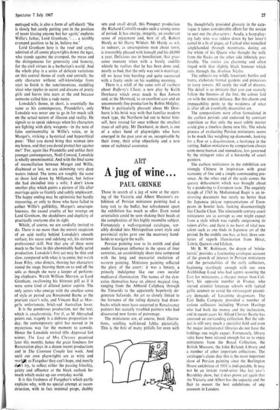A jug of wine ...
ART PAUL GRINKE
Those in search of a jug of wine at the open- ing of the Victoria and Albert Museum's ex- hibition of Persian miniature painting had a long trek to the buffet, but refreshment apart the exhibition has much to offer. Even noted orientalists could be seen shaking their heads at the complexities of this highly recondite subject. Fortunately a well-organised catalogue, sen- sibly divided into Metropolitan court style and provincial styles gave one the necessary hand- holds to navigate the walls.
Persian painting rose to its zenith and died under European influence in the space of four centuries, an astonishingly short time compared with the long and mercurial evolution of western painting. Miniature painting reflected the glory of the court: it was a luxury, a princely indulgence like our own secular mediaeval illumination. The names of the dyn- asties themselves have an almost magical ring, ranging from the Abbasid Caliphate through the Timurids to the apparently hopelessly de- generate Safawids. An art so closely linked to the fortunes of the ruling dynasty had draw- backs which must have occurred to Renaissance painters but scarcely troubled painters who had discovered new forms of patronage.
The miniatures are, of course, book illustra- tions, retelling well-loved fables pictorially. This is the first of many pitfalls for even with
the thoughtfully provided glossary in the cata- logue it takes considerable effort for the novice to sort out the characters : Azada, a harp-play- ing lady who was ridden down by her lover's camel in a fit of pique, or Farhad who tunnelled singlehanded through mountains, doting on the whim of his Queen who thought the milk from the flocks on the other side infinitely pre- ferable. The stories are charming and often tinged, with that slightly black humour which runs through the Arabian Nights.
The subjects are wildly luxuriant; battles and hunts, elaborate formal gardens and princesses in ivory towers. All surely the stuff of dreams. The detail is so intricate that you can scarcely follow the fineness of the line, the colour laid on with the utmost delicacy. But this charm and impeccability point to the weakness of what is after all an essentially decorative art.
The compositions were often formulated in the earliest periods and endorsed by constant repetition so that only the most subtle master could give a timeless theme new life. The whole process of evaluating Persian miniatures seems to be much like weighing up diamonds, looking for a flaw or a discoloration, a hesitancy in the cutting. Indian miniatures by comparison always seem more human and, immediate, less governed by the stringent rules of a hierarchy of court painters.
The earliest miniatures in the exhibition are strongly Chinese in inspiration with great economy of line and a simple commanding pre- sence. At the other end of the scale comes the queasy debasement which was brought about by a pandering to European taste. The ungainly nymph of 1765 by Muhammad Baqir is an in- teresting document but surely no better than the Japanese ukiyoe representations of Euro- peans in bowler hats, looking disconcertingly like Charlie Chan. The nineteenth century court miniatures are as corrupt as one might expect from a style which was rapidly outgrowing its raison d'etre, and there is no burst of vital new talent such as one finds in Japanese art of the period. In the middle one has, at best, three cen- turies of superb illumination from Herat, Tabriz, Qazwin and Isfahan.
Mr B. W. Robinson, the doyen of 'minia- turisti,' provides a fascinating catalogue account of the growth of interest in Persian miniatures and the personalities of the early collectors, beginning startlingly enough with our own Archbishop Laud who had agents scouring the East for miniatures, a sharper mover than Col- bert, his opposite number in France, who started oriental language schools with typical gallic acumen to avoid the extravagant pecuni- ary demands of Levantine dragomans. The East India Company provided a number of serious collectors including Warren Hastings who had both the money and the inclination, and in recent years Sir Alfred Chester Beatty has amassed an outstanding collection. But the sub- ject is still very much a specialist field and even the major institutional libraries do not have the holdings one might expect. Fortunately, library rules have been relaxed enough for us to enjoy miniatures from the Royal Collection, the British Museum, the John Rylands Library and a number of other important collections. The catalogue's claim that this is the most important show of Persian painting since the Burlington House exhibition of 1931 is indisputable. It may not be an instant trend-setter like last year's Beardsley show, but it does prove yet again that the Victoria and Albert has the capacity and the flair to mount the best exhibitions of any museum in London.






































 Previous page
Previous page